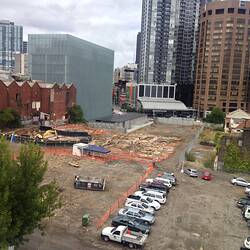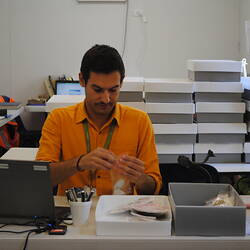Summary
The Carlton United Brewery (CUB) Collection consists of 2,187 artefacts excavated in early 2013 during an archaeological dig at the former Carlton and United Brewery site. The Carlton and United Brewery excavation contains evidence of some of Melbourne's earliest industry, in both corporate and production terms Melbourne was the centre of Australian brewing for many years.
The Carlton United Brewery (CUB) Collection consists of 2,187 artefacts excavated in early 2013 during an archaeological dig at the former Carlton and United Brewery site in Melbourne. The Carlton and United Brewery site is located at the north end of Swanston Street in the centre of the block bordered by Victoria, Swanston, Queensberry and Bouverie Streets in Carlton.
Brewing on the site dates to 1858 when the North Melbourne Brewery was established by Rosenberg & Co. at 24 Bouverie Street. The venture failed and was briefly reopened by John Bellman as the Carlton Brewery before being purchased by Edward Latham and George Milne in 1865. With the assistance of experienced brewer Alfred Terry, both production and the site were expanded with construction of large stables and cellars and the replacement of the original plant with a new brewing tower constructed of red and white bricks in the early 1870s. A wine and spirit store and bluestone warehouses were erected in the early 1880s, at which time Latham sold out to the Melbourne Brewing and Malting Co. although he retained an interest in the firm until the late 1880s. Expansion of the site continued into the 1920s, with the construction of the Malthouse in 1904. The site remained a working brewery until its closure in 1987 when Carlton & United Breweries consolidated operations at Abbotsford.
The site had rich layers of archaeology with evidence of residential use from the site's time before the development and expansion of the brewery, as well as physical evidence of more than a century of brewing activity. Artefacts excavated during the dig include domestic items such as ceramic saucers, perfume and sauce bottle stoppers, a fragment from a Chinese pickle jar, a broken cobalt blue castor oil bottle and the stem of a smoking pipe. From the brewery era are hundreds of ball shaped rubber 'bungs' or stoppers for barrels, and a three-metre iron furnace stoker.
Elements uncovered on the site include brick remains from the brewery boilers, a huge timber-lined well, a brick well, chimney and engine foundations, as well as stone laneways and building footings, evidence of the 19th-century brewery, shops and residences. The only visible relics of the site's 129 year history as a brewery are the Malthouse building on Swanston Street and the bluestone building-remains on Bouverie Street.
The Carlton and United Brewery excavation contains evidence of some of Melbourne's earliest industry. In both corporate and production terms, Melbourne was the centre of Australian brewing for many years, with Carlton & United Breweries still Australia's largest brewer (in 2014). Carlton & United Breweries (CUB) was formed when the Carlton, Fosters, Victoria, Shamrock, Castlemaine and McCracken breweries united in 1907.


